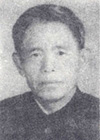

Wang Peizhong (1925- ) is a native of Fengqiu, Henan province. He graduated from Shanghai National Defense Medical Center in 1949. He was now dean of nasopharynx cancer research office and chief physician of People's Hospital, Guangxi Zhuang Autonomous Region. He has engaged in clinical diagnosis and cure of nasopharynx cancer since 1949. In 1978, he, together with Zeng Yi, found nasopharynx cancer is closely related with EB virus. He discovered early nasopharynx cancer with no clinical symptom through general serological survey. He was the first one to set up serological prospective research field of nasopharynx cancer. He also initialized research on the relations between predisposing gene and heredity of nasopharynx cancer through study on HLA of high incidence families of nasopharynx cancer. He won a number of awards, such as Medical Science and Technology Progress Award, awarded by China Ministry of Health.
EARLY DIAGNOSIS, PROSPECTIVE AND ETIOLOGICAL STUDIES ON NASOPHARYNAGEAL CARCINOMA
Zeng Yi, Wang Peizhong and Deng Hong
(Institute of Virology, Chinese Academy of Prevention Medicine Guangxi Autonomous Regional Hospital Wuzhou Cancer Institute)
Abstract
Nasopharyngeal carcinoma (NPC) is common in southern China. The purpose of our studies was to establish simple and sensitive techniques for early diagnosis of NPC and to clarify the role of Epstein-Barr (EB) virus, environmental factors and genetic factors in the development of NPC.
EB Virus and NPC
Early diagnosis and prospective studies are given below. Serological mass surveys of NPC were carried out in NPC high risk areas (Cangwu County and Wuzhou City) by immunoenzymatic test, and IgA/VCA antibody positive persons were followed up yearly for 10 years. The early detection rate increased from 18.6% to 81% in Cangwu County and from 32% to 92% in Wuzhou City. In the course of following-up IgA positive asymptomatic individuals, IgA/VCA antibodies could be detected 12 years before NPC onset. The IgA antibody titers were also followed up, 40.7%and 7.3% of IgA antibody positive persons had antibody titer stable and increasing, respectively. It is interested that most of NPC were detected from the group with increasing or stable IgA antibody titer. The titer of IgA antibody to VCA and EA is proportional to the detection rate of NPC. These data indicate that the detection of IgA antibodies to EB virus VCA and EA is very useful for early diagnosis of NPC. Beside IgA/VCA and IgA/EA antibodies, IgA/MA, IgA/EBNA-1and IgG/Z antibodies are also specific and valuable for NPC diagnosis.
EB Virus Inducers and Tumor Promoters
Ether extracts from 1693 plants ,including Chinese medicinal herbs ,were studies for EB virus inducer activity and more than fifty were found to have inducing activity. Many plants such as Aleurites fordii, Wikstroemia indica, Sapium sebiferum and Euphorbia antiquorum grow in high risk areas for NPC. EB virus inducers were found in the soil and they were also found in vegetables growing in such soil in southern China. Extracts from plants and herbs containing EB virus inducers can enhance lymphocyte transformation by EB virus in vitro as well as tumor growth by the Rous sarcoma virus, rabbit papillomavirus, DMBA, methylcholanthrene and dinitrosopiperazine (DNP).
The salted fish from southern China and harisa and qaddid from Tunisia contain EB virus inducers. These preserved foods are very frequently consumed in high risk areas for NPC. Mutagens were also detected in the same food extracts, this being the first time that EB virus inducers and mutagens were found to be present in the same foods. Our data demonstrate that EB virus inducers can enhance lymphocyte transformation by the virus as well as promote the development of NPC in rats by DNP.
The genetic basis for NPC
Linkage studies were started in an attempt to demonstrate the existence of a disease susceptibility gene closely linked to HLA locus A and B but distinct from them which would confer a high relative risk for this disease. A total of 29 sibships with more than one case of NPC were studied. This study has provided clear evidence for the existence of NPC disease susceptibility gene, tightly linked to the HLA region.
In conclusion, the etiological factors for the development of NPC are complicated, the EB virus plays an important role in the development of NPC, but it is not the unique factor, the genetic factor and the environmental factors are also involved in the development of NPC.